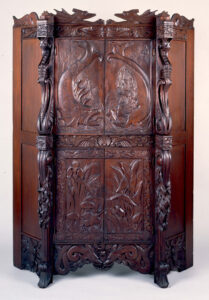Bror Anders Wikstrom
Artist and designer Bror Wikstrom was active in New Orleans from 1883 to 1909 and was particularly well-known in the city for designing Carnival pageants.

Courtesy of New Orleans Museum of Art.
Artist Bror Anders Wikstrom referenced his earlier years as a sailor in the ornamentation of the doors on this mahogany "Cabinet," built ca. 1900-1905.
Aman who pursued several careers during his lifetime, Bror Anders Wikstrom began working by going to sea from his native Sweden as a boy, eventually rising in rank, it is believed, to captain. When he became nearsighted, he decided to forsake his maritime life and become an artist. Born on April 14, 1854, he studied at the Royal Academy of Stockholm and later with the artists Rodolphe Julien and Filipo Colarossi in Paris. Following his studies, he became a magazine illustrator, printmaker, set designer, advertising designer, teacher, portrait painter, cartoonist, and muralist. Active in New Orleans from 1883 to 1909, Wikstrom was particularly well known in the city for designing Carnival pageants, especially for the krewes of Rex and Proteus.
In 1881, when Wikstrom was hired to illustrate a story about life at sea, he decided to draw the scenes he had observed on trips between the Netherlands and the United States, a project that led to his decision to stay in the United States. After a year in Florida he visited New Orleans, where he drew cartoons for the covers of the Mascot in 1883 and Figaro in 1884. On a second visit to the city during the World’s Industrial and Cotton Centennial Exposition in 1884-85, he met a friend, probably Charles Briton, who was engaged in designing Carnival pageants. Wikstrom joined him in the enterprise and, after his colleague’s death, became the best-known Carnival designer in New Orleans during the 1880s and 1890s.
Wikstrom was active in many art activities in New Orleans. With fellow artists Paul Poincy, Andres Molinary, and Achille Perelli he helped to found the Artists’ Association of New Orleans in 1885. He went on to teach at its art school, and in 1890 became its treasurer; he served as president in 1892 and from 1895 to 1896, and as corresponding secretary from 1899 to 1903. He also founded (and financially supported) a short-lived literary and artistic journal titled Art and Letters. His etchings served as its illustrations.
The marine paintings that Wikstrom based on sketches made on his annual summer vacations sailing in Europe and the Caribbean were highly popular during his lifetime. He was also known for his Louisiana landscapes as well as portraits and historical subjects. He exhibited at Seebold’s, at the Artists’ Association of New Orleans, the 1897 Tennessee Centennial Exposition in Nashville, Tennessee, the Art Association of New Orleans, the Louisiana Historical Society, and the1904 Louisiana Purchase Exposition in St. Louis, Missouri.
Bror Wikstrom died in New York City on April 27, 1909, while working on a design for a parade for the Hudson-Fulton Celebration, a joint commemoration of the 300th anniversary of Henry Hudson’s discovery of the Hudson River and the 100th anniversary of Robert Fulton’s successful commercial application of the paddle steamer. Today many of Wikstrom’s paintings, such as Mangrove Swamp (1902), along with some of his etchings, Carnival sketches, and even some of his tools, can be found at the Louisiana State Museum in New Orleans.
